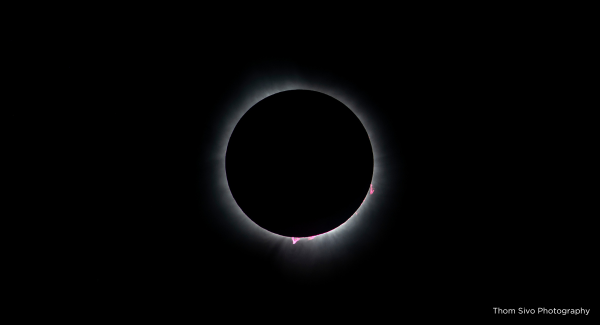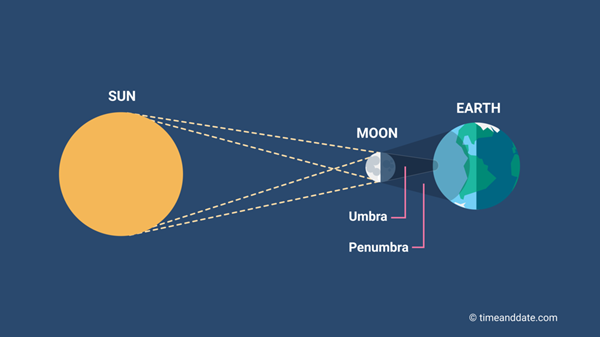
Monday, April 8, offered the residents of Northeast Ohio an extraordinary opportunity—the chance to witness a total solar eclipse from their hometown. Nearly 5,000 attendees joined the Cleveland Museum of Natural History’s Total on The Oval community watch party to witness this once-in-a-lifetime cosmic spectacle.
 In Cleveland, where April weather is known to be unpredictable, the clouds yielded to provide a warm, sunny day—and a breathtaking view of totality. What an incredible chance for the community to witness this natural phenomenon surrounded by their friends, family, and neighbors! Total on the Oval was attended by visitors from across Northeast Ohio and the country, and even drew eclipse-chasers from around the world. Local and national media also took great interest in the Museum’s eclipse events.
In Cleveland, where April weather is known to be unpredictable, the clouds yielded to provide a warm, sunny day—and a breathtaking view of totality. What an incredible chance for the community to witness this natural phenomenon surrounded by their friends, family, and neighbors! Total on the Oval was attended by visitors from across Northeast Ohio and the country, and even drew eclipse-chasers from around the world. Local and national media also took great interest in the Museum’s eclipse events.
 Alongside engaging presentations by Museum Astronomers Nick Anderson, Destiny Thomas, and Monica Marshall, the Museum was thrilled to welcome retired NASA Astronaut Mike Foreman, who participated in fascinating conversations about the more than 637 hours he spent in space during two space shuttle missions, STS-123 and STS-129. Foreman also joined the Museum’s Board of Directors for a special luncheon, where he answered questions about what it feels like to count down to liftoff in a space shuttle—and to look down on Earth from above. And during a public Q&A session directly following the eclipse, when Foreman was asked to describe the experience, he summed it up in one word: “Awesome!”
Alongside engaging presentations by Museum Astronomers Nick Anderson, Destiny Thomas, and Monica Marshall, the Museum was thrilled to welcome retired NASA Astronaut Mike Foreman, who participated in fascinating conversations about the more than 637 hours he spent in space during two space shuttle missions, STS-123 and STS-129. Foreman also joined the Museum’s Board of Directors for a special luncheon, where he answered questions about what it feels like to count down to liftoff in a space shuttle—and to look down on Earth from above. And during a public Q&A session directly following the eclipse, when Foreman was asked to describe the experience, he summed it up in one word: “Awesome!”
 The Museum is proud to have been part of this spectacular event in collaboration with University Circle Inc. We hope it will inspire in all our visitors a renewed sense of wonder at the natural world—and a greater interest in learning about astronomy, science, and nature in the future. If you can’t wait for your next opportunity to be awed by the natural world, be sure to visit the Museum’s schedule of programs and events. This work is supported by the Simons Foundation and is part of its 'In the Path of Totality' initiative.
The Museum is proud to have been part of this spectacular event in collaboration with University Circle Inc. We hope it will inspire in all our visitors a renewed sense of wonder at the natural world—and a greater interest in learning about astronomy, science, and nature in the future. If you can’t wait for your next opportunity to be awed by the natural world, be sure to visit the Museum’s schedule of programs and events. This work is supported by the Simons Foundation and is part of its 'In the Path of Totality' initiative.
The Science of a Solar Eclipse
A solar eclipse happens when the Moon passes between the Sun and the Earth—covering the face of the Sun. This celestial phenomenon occurs two to four times per year.

Eclipse Animations
We've got you covered! The Museum's Digital Department partered with our astronomers to develop these animations for go-to explanations about the science of eclipses and how to view them safely.

Museum Astronomers
 Nick Anderson earned a B.S. in astrophysics and planetarium studies from Bowling Green State University (BGSU) in 2014. After serving as console operator for the BGSU Planetarium, Anderson moved to the Cleveland area, where he worked as a Planetarium Specialist at the
Nick Anderson earned a B.S. in astrophysics and planetarium studies from Bowling Green State University (BGSU) in 2014. After serving as console operator for the BGSU Planetarium, Anderson moved to the Cleveland area, where he worked as a Planetarium Specialist at the Schuele Planetarium and went on to receive an MBA from Cleveland State University. He joined the Cleveland Museum of Natural History in early 2017 as Astronomy Education Coordinator.
 Destiny Thomas earned a B.A. in physics and astronomy with a minor concentration in philosophy from Emory University. Dedicated to STEM education and community engagement, Destiny served as STEM Learning Teacher and Guest Engagement Specialist at the Great Lakes Science Center. More recently, she has held roles as Community Programming Coordinator and Museum Educator at the Cleveland Museum of Natural History, where she currently serves as Museum Astronomer.
Destiny Thomas earned a B.A. in physics and astronomy with a minor concentration in philosophy from Emory University. Dedicated to STEM education and community engagement, Destiny served as STEM Learning Teacher and Guest Engagement Specialist at the Great Lakes Science Center. More recently, she has held roles as Community Programming Coordinator and Museum Educator at the Cleveland Museum of Natural History, where she currently serves as Museum Astronomer.
 Monica Marshall earned a B.A. in sustainability studies and counseling psychology from Alaska Pacific University. While
Monica Marshall earned a B.A. in sustainability studies and counseling psychology from Alaska Pacific University. While in college, Monica founded an environmental club that won awards for stewardship.
Passionate about sharing her knowledge with others, Monica has served in education- and community-centered roles, including lead program instructor with Footpath Foundation and lead naturalist and preschool teacher at the Cleveland Metroparks.
The Simons Foundation’s Science, Society and Culture division seeks to provide opportunities for people to forge a connection to science—whether for the first time or a lifetime. Through our initiatives, we work to inspire a feeling of awe and wonder, foster connections between people and science, and support environments that provide a sense of belonging. The Simons Foundation’s mission is to advance the frontiers of research in mathematics and the basic sciences. Since its founding in 1994 by Jim and Marilyn Simons, the foundation has been a champion of basic science through grant funding, support for research and public engagement. We believe in asking big questions and providing sustained support to researchers working to unravel the mysteries of the universe. Through our work we make space for scientific discovery.